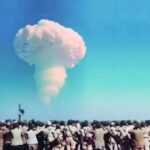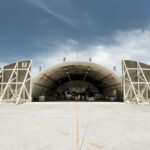Testing the test-ban treaty: An inspection exercise in Kazakhstan
By Rebecca Johnson | September 15, 2008
The Comprehensive Test Ban Treaty Organization (CTBTO) launched the longest and most complex of its verification field exercises on September 1, with a hypothetical scenario: In late August, the CTBTO’s International Monitoring System detected seismic signals from underground shocks that looked as if they might have come from a clandestine nuclear test in the vast territory of Arcania, a fictional Central Asian republic where more than 20 nuclear weapons test explosions had been openly conducted during the Cold War.
The Comprehensive Test Ban Treaty Organization (CTBTO) launched the longest and most complex of its verification field exercises on September 1, with a hypothetical scenario: In late August, the CTBTO's International Monitoring System detected seismic signals from underground shocks that looked as if they might have come from a clandestine nuclear test in the vast territory of Arcania, a fictional Central Asian republic where more than 20 nuclear weapons test explosions had been openly conducted during the Cold War. Arcania explained the event as a "shallow, natural earthquake" some 20 kilometers away from the epicenter estimated by the International Data Center. Rejecting this explanation, one of Arcania's neighbors, Fiducia, put in a formal request to the CTBTO for an on-site inspection (OSI) to determine whether this event was a nuclear explosion, in violation of the Comprehensive Test Ban Treaty (CTBT).
To support its OSI request, Fiducia included information based on its own observations of an increase in military activities near the site and its detection of cesium 137 a few days after the seismic event. Both Fiducia and Arcania are states parties to the CTBT, which opened for signature in 1996. Arcania says that its last nuclear explosion was conducted in 1989, but it has never joined the Nuclear Non-Proliferation Treaty or permitted International Atomic Energy Agency inspections at its nuclear facilities, which it claims are solely for peaceful purposes.
One hundred and eight-five people gathered in a windswept plain in the middle of the Central Asian steppes, at what used to be the Soviet Union's Semipalatinsk nuclear test site, to act out this scenario as part of the 2008 Integrated Field Exercise. The participants were divided into two primary groups, the Arcanians, otherwise known as the Inspected State Party, and the CTBTO's 39-member Inspection Team. Additional attendees included representatives of the host, Kazakhstan, who provided support, ranging from transport and food to emergency, fire, and medical facilities; OSI exercise evaluators; observers; staff from the CTBT's Provisional Technical Secretariat; and members of the media.
Among the observers were representatives of several states signatories, including China, France, Germany, Iran, Israel, Spain, and Britain. A U.S. film crew and a few U.S. specialists, none of whom formally represented the U.S. government, also attended. (The Bush administration has withheld some of its funding for the establishment of the CTBT's verification regime, including inspections.) The United States, which was the first country to sign the CTBT in September 1996, is among the nine states whose ratification is required before the CTBT can enter into force. China, Egypt, Iran, and Israel, who have also signed but not ratified the treaty, also participated in the exercise. Another non-ratifying signatory, Indonesia, was not present, neither were representatives from India, Pakistan, and North Korea, who have not signed the treaty.
The OSI exercise began in Almaty, Kazakhstan's commercial capital, which doubled as Arcania's capital, Utopium. On the morning of September 1, the head of the CTBTO inspection team, Wang Jun, presented the director of Arcania's Disarmament Department, Ministry of External Affairs, John Walker, with the Inspection Mandate that had been drawn up following Fiducia's request for an inspection. Walker formally accepted the mandate but indignantly noted, "one of our neighbors is behind this unwarranted slur on our integrity and compliance with our international legal undertakings." Arcania also refused to allow the designated representative of Fiducia, Col. Ayam Aspay, to join the inspectors. Walker explained the events as Arcania saw them and predicted: "If both we and the inspection team follow the guidance in the treaty and protocol, we will be able to address the non-compliance concern." Noting that the area in question contained militarily sensitive sites and boreholes from nuclear tests prior to 1989, he also warned the inspectors that Arcania would maintain its "right to protect confidential information."
Once Wang Jun had given the Arcanian delegation the CTBTO's OSI mandate, which included a list of inspectors, techniques, and equipment that could be deployed, the two sides got down to business. The CTBTO team identified an inspection area of 1,000 square kilometers and presented its inspection plan for the first few days. Arcania immediately objected to the proposal for overflights and insisted on designating one large area a no-flight zone and another a low-flight zone. Its representatives also argued that the treaty required only one overflight, and that is all they intended to permit. Arcania then identified several "restricted access areas," giving reasons ranging from national security to health and safety, such as radioactive contamination from tests conducted 20 years ago or unexploded ordinance from a recent military exercise. The inspection team had to negotiate around these objections and get agreement on overflights and ground inspections that would enable it to determine whether a nuclear test had taken place. As part of the exercise scenario, it is expected that the Arcanians will attempt to thwart and delay the inspections planned by the CTBTO's team–not necessarily because they are hiding a nuclear test (the inspection team doesn't know that yet) but because they have other secrets that they want to keep confidential. The success of the OSI will hinge on how successfully the inspection team is able to negotiate with the Arcanians and resolve such conflicts in order to complete its mission within the allocated time.
Starting on September 2, the exercise changed locations. All of the participants piled into a train bound for Semey (formerly Semipalatinsk). It travelled slowly for 21 hours past lakes and dry steppes, through villages where local women hocked delicacies such as apples, melons, smoked fish, and grilled chicken to passengers. At Semey, we boarded a fleet of battered but robust buses that drove us first to the legendary Kurchatov, one of the most important closed nuclear cities of the Soviet era. There, the grand houses once occupied by the Soviet Union's most important nuclear weapons scientists stood abandoned by the river, with weeds growing through their roofs and tennis courts. From Kurchatov, we travelled deep into the Semipalatinsk test site. Just before the sun disappeared below the horizon, the buses reached the white and green tents that made up the base of operations, which were set up a couple of kilometers outside the designated inspection area. This would be our home for a while.
Despite the dark and cold, Arcania's equipment specialist, Li Hua, began checking through the inspection team's equipment. Time and again, he found broken seals on the equipment containers, and even though the team argued that many of these seals had been broken inside the host country, Li sternly insisted on checking that the equipment accorded with the specifications he had been given. The next day the planned overflight was postponed as the morning had to be devoted to further equipment checks and health and safety briefings. In the afternoon, teams went out to take photographs and place the first seismometers in different locations around the inspected area. Then the weather turned, bringing heavy rain and wind. The overflights were cancelled for a second day, though a few ground teams were sent out to install monitoring equipment and pick up data from the sensors they had placed the day before. They arrived back at the base camp soaked to the skin. Overnight the weather grew even worse, and the overflights were cancelled again.
Did Arcania violate its treaty obligations or did it simply suffer a small earthquake inconveniently close to its former test site and sensitive military facilities? Only an on-site inspection will be able to tell. And only if it is carried out effectively. That's why 185 people are battened down in their tents in the howling winds and rains of the Kazakh plains.
Together, we make the world safer.
The Bulletin elevates expert voices above the noise. But as an independent nonprofit organization, our operations depend on the support of readers like you. Help us continue to deliver quality journalism that holds leaders accountable. Your support of our work at any level is important. In return, we promise our coverage will be understandable, influential, vigilant, solution-oriented, and fair-minded. Together we can make a difference.
Topics: Nuclear Weapons















